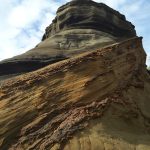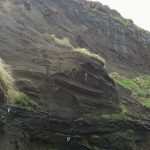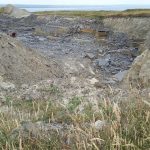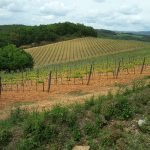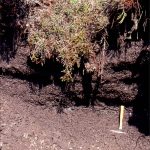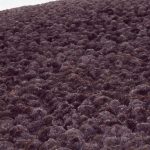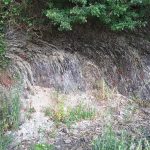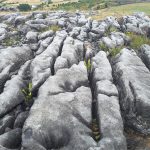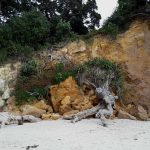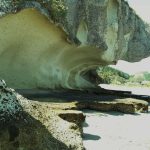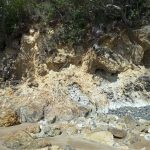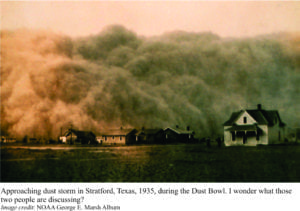Soil, dirt, mud; weathering processes
The stuff kids get covered in when they’re having fun.
A veneer on Earth’s crust that provides sustenance in one form or another for all land-air living creatures, including us. Without soils there would be no food web. No us!
Homo sapiens has learned to use soil to her advantage; growing things to eat, to construct shelter, to decorate. We have learned to utilize soils to the hilt. In fact on a global basis we have taken so little care of them that they have become an endangered species. In our haste to produce food, to irrigate, to scythe through forests, to clear land for some other use, we have damaged soils, in many cases beyond repair. Humanity, in its ignorance, greed and hubris, has managed to seriously compromise the utility of soils – the very things that make life viable.
From a structural perspective soils are quite simple; there is topsoil that contains a mix of organic matter derived from plants, macro- and micro-organisms, plus minerals derived primarily from the underlying sediment or rock (parent material). This structure is illustrated in the profile image above.
From a biological perspective, soils are complex. Apart from the obvious worms and small critters, there is a burgeoning microflora – fungi and bacteria; and it is the microflora that does most of the work to create a vital growing medium. The microflora breaks down fresh organic matter converting it to humus, and converts nutrients like nitrogen, potassium, phosphorous and many trace elements, into water-soluble forms that plants can metabolize. A vital topsoil requires a healthy microbiota. Soils that are regularly exposed to herbicides, bactericides and fungicides will, over time, become depauperate in useful microflora.
Classification of soils can be complicated. In this Atlas I use a simple textural classification, summarized in the diagram below. It is a US Dept. of Agriculture classification; most other countries use this or slightly modified versions.
This link will take you to an explanation of the Atlas series, the ownership, use and acknowledgment of images. There, you will also find links to the other Atlas categories.
Click on the image for an expanded view, then the ‘back page’ arrow to return to the Atlas.
The images
Left: Silt-sand loams developed on Late Pleistocene fluvial pebbly volcaniclastics (Hinuera Formation, Waikato, NZ). The transition from modified sediment to parent material is irregular. Right: Topsoil developed on multiple ash layers; remnants of an older (fossil) soil is located above the pale band of ash (Waikato, NZ).
Thin (pumice) loam on airfall ash, that overlies partly welded ignimbrite (the orange ash layers may be co-ignimbrite). Iron oxide staining indicates groundwater seepage and mineral alteration. Mamaku, north of Rotorua N.Z.
Three sets of small V-shaped paleovalleys and intervening ridges cut into welded Mamaku Ignimbrite (about 220,000 years old), draped by at least three ash fall deposits and thin paleosols (paleosoils). The entire outcrop is overlain by a more recent soil and modern vegetation. North of Rotorua, NZ
Thin sandy loam topsoil and iron-stained layer on coastal plain gravels. The upper part of the topsoil has been disturbed by cultivation. The normal position of the watertable is at the transition to gray gravel. Kaiua, Thames coast east of Auckland, NZ.
Eroded sections of coastal dunes, Raglan, N.Z.. Spinifex roots penetrate up to 2m into the sand. Soils here are very low in organic matter, almost 100% sand with high permeability and little capacity for water retention.
Coastal dune root systems (Spinifex and Lupin). Much of the organic matter is oxidized rapidly. Dune instability means that topsoil formation is meagre.
Pleistocene dune sands are overlain by peat and leaf litter from an ancient coastal, Podocarp forest. Left: Old dunes cut by an uplifted marine terrace, capped by peat. Right: Cross-bedded dune sands overlain by thin woody peat (O layer). The B layer here is sand enriched in iron oxides precipitated by ancient fluctuating water tables. Great Exhibition Bay, northern NZ
Pleistocene woody peat and leaf litter at top (O layer), underlain by thick, blocky weathered, silt loams with abundant roots and buried logs. Great Exhibition Bay, northern NZ
Semiconsolidated, cross-bedded Pleistocene dune sands beneath a peat. Here, the parent sands have reduction spots derived from leaching of iron oxides. Great Exhibition Bay, northern NZ
Liesegang rings are a common manifestation of shallow weathering in permeable sandstone. The ring-like patterns form as iron oxides precipitate in concert with migrating groundwater. Mokau Sandstone, north Taranaki, NZ
Left: Remnants of a soil formed over stabilized Pleistocene dune sands. The abrupt steep-dipping contact with a younger set of dune deposits is delineated by resistant limonite pans. Right: The muddy loam indicated as ‘P’ represents a small Pleistocene interdune pond or lake; here overlain by multiple dune crossbeds. Kariotahi, west Auckland, NZ
Above left and right: Spheroidal weathering of basalt flows associated with the Late Pliocene Karioi Volcano. Spheroids are bound by columnar joints from the original flow. Right image shows incipient honeycomb weathering of the spheroid surface, from continued sea spray and salt precipitation.
Above left and right: Honeycomb weathering of spheroids on basalt flows exposed to continuous seawater spray. Late Pliocene Karioi Volcano. Spheroids are bound by columnar joints from the original flow.




Left: Profile of muddy loam developed on weathered turbidite sandstone-mudstone. Near Wellsford, north Auckland NZ. Right: Silty clay loam developed on Carboniferous shale, Cliffs of Moher, west Ireland
Gravelly clay loams and clays developed on steep alpine mountain slopes, Mt. Garibaldi, British Columbia. The organic layer is either very thin or absent. On the left, the parent material is probably lacustrine clay.
Typical stoney silt-clay loams of Tuscany; the location of Chianti Classico and olives. Bedrock parent material consists of Cretaceous-Paleogene marls, sandstones and shales. Left and Center: The 12th century fortification is Monteriggioni. Right: The hilltop village of Montefioralle.
Arctic soils riven with permafrost. Left: Frozen muddy loam undergoing summer melt. Right: typical patterned ground in Arctic tundra.
Arid soil in the Chilean Atacama commonly lack any organic component. Left: exposed surface of an inactive alluvial fan contains a mix of stoney material, sand, silt and mud. Calcite cements are common in some deposits. Right: Desert varnish, a common feature of prolonged, arid climate weathering. The varnish consists of silica, iron and manganese slowly leached from the original rock, and re-precipitated as oxides.
Weathering of basaltic lapilli below a very thin, incipient topsoil, shows gradual redistribution of iron oxides. The volcanic deposits are very young – about 800 years. Rangitoto, Auckland, NZ
Left: Soil creep in sub-vertical shale, east Kansas, beneath a stoney clay loam. Center and Right: Old Red Sandstone bedrock extends into the low cliff where it is broken and gradually incorporated into gravelly colluvium by soil creep. The overlying thin sandy loam is formed predominantly on wind-blown sand. Red Strand, south Ireland.
Soil creep in vertically dipping Devonian shale acts to incorporate shale slivers into the overlying clay-silt loam. Kinsale, south Ireland.
Karst, common weathered landforms in carbonate rocks. Left: Clints and grykes formed by dissolution of carbonate along fractures in Carboniferous limestone, Burrens, Ireland. Right: Pinnacle dissolution structures in jointed Oligocene – Early Miocene limestone, Takaka, NZ (Image by Kyle Bland, GNS).
Weakening of flow-banded rhyolite by tree roots can be a significant cause of cliff erosion. Hahei, New Zealand.
Localized hydrothermal alteration of flow-banded rhyolite (orange iron-enriched zone) has weakened the rock. Collapse of the cliff is exacerbated by soil formation and tree roots. Hahei, New Zealand.
Coastal exposure of partially welded Ignimbrite sculpted by wave, wind and rain. Flaxmill Bay (south of Whitianga), New Zealand
Mineral replacement and oxidation of rhyolite along fractures, where fractures act as conduits for groundwater seepage
Weathered flow banded rhyolite, with iron oxides concentrated along fractures and flow bands that have high iron-bearing ferromagnesian minerals like pyroxenes






















